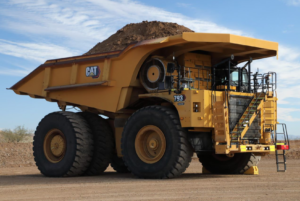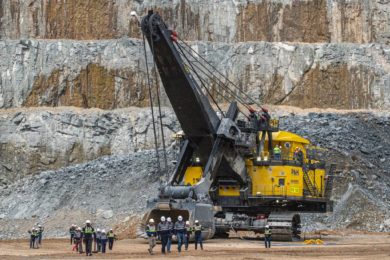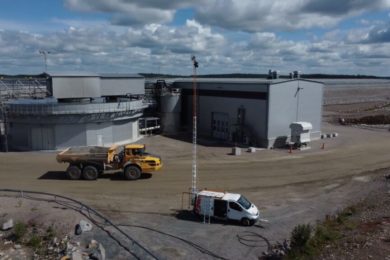In November 2022, Caterpillar announced the successful demonstration of its first battery electric 793 large mining truck as well as a significant investment to transform its Arizona-based proving ground into a sustainable testing and validation hub of the future.
Caterpillar completed development of its first battery electric 793 prototype with support from key mining customers participating in Caterpillar’s Early Learner program. Participants of the program with definitive electrification agreements include BHP, Freeport-McMoRan, Newmont Corporation, Rio Tinto and Teck Resources Ltd. Subsequently, in April 2023, Nouveau Monde Graphite Inc (NMG) and Caterpillar Inc signed definitive agreements to supply NMG’s Matawinie Mine with an integrated solution that covers a zero-exhaust emission fleet, supporting infrastructure, and service.
All of these mining groups, and many more, are sending delegations to The Electric Mine 2023 conference, being held May 23-25 in Tucson, Arizona, where six months on from the battery electric 793 prototype demo, Denise Johnson, Resource Industries Group President at Caterpillar, will be one of two keynote speakers on Day 1 of the event.
We spoke to Denise just prior to The Electric Mine to get an update on Caterpillar’s Early Learner program, its close collaboration with customers, plus the wider zero emissions transition journey in mining.
IM: Your keynote is titled: ‘Together we are mining, more sustainably.’ Would you say that the various parts of the mining ecosystem are collaborating more now in the pursuit of decarbonising mining operations than they have in the past? How is this enabling you to accelerate your zero emissions solutions?
DJ: When we think about collaboration we have to think about it in two dimensions – externally with our customers and internally across our company. The energy transition required us to take a different and accelerated approach to product development and change management and learning. In 2021, we launched our Early Learner program, working with some of the world’s largest global mining customers, including BHP, Freeport, Newmont, NMG, Rio Tinto and Teck. As part of this program, we are delivering a pre-pilot version of our battery electric truck to our Early Learner customers’ sites – allowing them to test the product in real-world applications, earlier than ever before. The Early Learner program has also brought together teams from across Caterpillar to develop a common set of advanced power solutions to integrate into our equipment and across the industries we serve.
Caterpillar’s first battery electric 793 large mining truck at its Tucson Proving Ground

IM: Clearly charging strategy and autonomy are just as important a part of the mix as the battery trucks themselves – what is Caterpillar’s vision for an integrated zero emissions haulage solution?
DJ: Supporting our customers through the energy transition is about more than just a change to the truck – it requires a significant change to site infrastructure. The electrical energy required to run a mine site will be much greater than it is today, especially when managing the high energy swings that occur during a charging event. We see that there will likely be many more sources of power generation and storage on a mine site in the future, including solar, wind, alternative fuels, and energy storage systems. There is a unique roadmap for every site that is required for products, people, processes, technology and infrastructure. That information is used to develop a structured energy transition program. We are uniquely positioned to deliver a holistic site solution given the breadth of our portfolio offerings, including machines, technologies, and energy solutions.
IM: You have had many customers now visit TPG to see the prototype – what has feedback been like and what are their main concerns about the reality of deploying battery trucks?
DJ: The purpose of building our prototype battery electric 793 was to provide a foundation for our development process, which depends on complex simulation of components and machine systems. We are extremely happy with the truck’s performance and wanted to share what we’ve learned thus far with our Early Learner program participants. When we showcased the truck in November of last year, the customers were very excited to see the truck performing the functions of a typical mining truck. But the real excitement for our engineers was monitoring the more than 1,100 data channels attached to the truck, providing visibility to 110,000 data points per second! This information is what is driving our designs for the next phases of our program. We are sharing information and seeking input from our Early Learner customers through a series of detailed design reviews aimed at ensuring site readiness as we work together to prepare for the next round of trucks to hit the dirt on our customers’ sites.
IM: How are you making sure that the Cat network of dealers is ready for the challenge of zero emissions haulage?
DJ: As part of the Early Learner program, our Cat dealers aligned to each of the Early Learner sites are participating in ongoing learning and collaboration sessions as we prepare to send our next phase of battery electric trucks to the customers’ sites. Our dealers are assisting in critical, on-site support and are integrated into our global dealer development. This is one more example of the emphasis we are placing on learning and change management through our Early Learner program. Their experiences will serve as a baseline for broader dealer learning and training as we get closer to full production and deployment.
IM: Likewise, it is inevitable that these machines will not appear overnight as full fleets – they will be phased in, while some mines will opt to first deploy the latest diesel-electric trucks with Tier 4 engines first with a view to going battery later. Are you working on having multiple ‘routes to net zero’ for customers based on their needs?
DJ: Every energy transition journey is unique. This is true for every customer and for every site. Some of our customers are ready to make a full transition to electrified solutions as soon as the products are commercially available, while others are looking for a longer-range or bridging strategy. We know it will take more than one product to help our customers achieve their climate and business objectives.
IM: Can you talk a bit about how the Early Learner program will work and the approach you are taking?
DJ: As an industry, miners share many common priorities – the safety of their people, the operational efficiency of their sites, minimising the impact of their actions on the communities where they operate. Part of what makes this program unique is our approach to industry learning. We are bringing together representatives from each customer with their Cat dealers to discuss and problem solve real-world applications of electrified solutions. There is no handbook or standard work for how you electrify a mine site – everyone is new to this and trying to learn alongside one another, creating the instruction manual along the way! If we can share what we learn between one another, it will ultimately help drive the industry’s adoption of more sustainable solutions.
IM: Beyond haulage, do you see a role for battery versions of other machines whether water trucks, wheel loaders, shovels, etc?
DJ: The energy transition includes not only the hauling units but also supporting and loading equipment. The rate of adoption for these machines will be highly dependent on their impact to greenhouse gas reduction. We are currently assessing the demand and prioritisation of additional machines based on input from our customers. More to come in the future!
Denise Johnson, Caterpillar Resource Industries Group President, will present: ‘Keynote: Together we are mining, more sustainably’ at The Electric Mine 2023 conference in Tucson, Arizona, on May 23 at 8:30-9:00. For more information on this three-day event, head to www.theelectricmine.com










